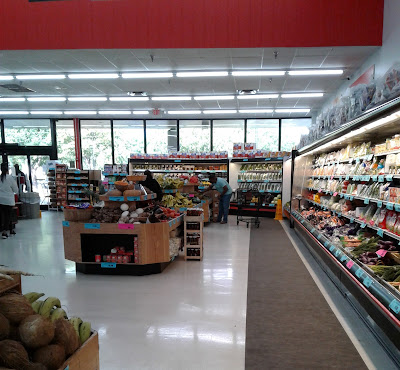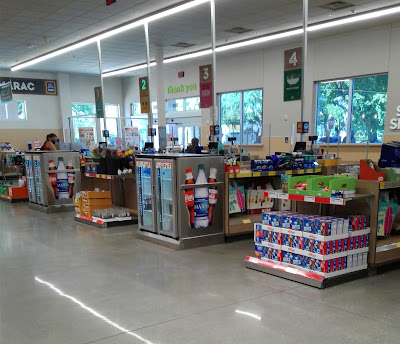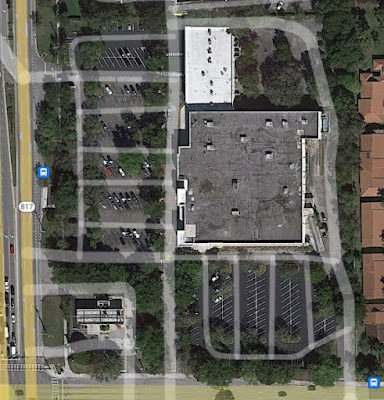Publix #202 (The Original)
6820 North University Drive, Tamarac, FL - University Commons
Picking up from where we left off at the end of my previous post, we return to Tamarac and the intersection of University Drive and McNab Road. At this intersection once resided an Albertsons, a Winn-Dixie, and a Publix, of which we explored the former two of those last time. In today's post it's time to take a closer look at the intersection's Publix store. Even though Publix vacated this building many years ago, quite a bit from Publix's short time in this building was left behind, which we'll be taking a look at today.
The original Publix #202 opened on October 6, 1977, a rather average 1970's built store. The original Publix #202 had a rather short life, lasting only 9 years before it was replaced by the much larger and more prominent store #302 at Midway Shopping Center 1 mile south of here at the intersection of University Drive and Commercial Boulevard. I've seen a few examples in the past where Publix replaced a store after only 10 years or so, presumably bailing on the locations after the first 10 year lease term was up. Store #302 is one of Publix's 56E prototypes, the largest and most deluxe store design of the time. Compared to the tiny old store #202, with its equally as small parking lot tucked away in a tiny shopping center, store #302 was a huge improvement from a real estate perspective. While the original Publix #202 had a short life when it closed for good on November 3, 1986, the night before store #302 opened, #302 was a huge upgrade from the store that served the area prior. Following the closure of the original Publix #202, that store number would later be recycled for a new (and completely unrelated) location in Melbourne, FL that opened on July 2, 1987 and closed in April 2022.
Following Publix's big move down the road in late 1986, the former supermarket building would sit empty for about a year until a new tenant, Silk Greenhouse, opened in the space in late 1987. Silk Greenhouse was a retail chain based out of Tampa, founded in 1983 and specialized in selling fake flowers and plants. Silk Greenhouse boomed into a large chain of nearly 100 stores in 23 states at their peak, with most of those locations in their home state of Florida. Silk Greenhouse grew to be large enough by the late 1980's, that they would begin to claim themselves as the United State's largest importer of fake flowers. Even though fake flowers seemed to be all the rage in the late 1980's, Silk Greenhouse ended up declaring bankruptcy in 1991, with the entire chain closing for good shortly after that. Following the closure of Silk Greenhouse, the building sat empty for a while before becoming home to a Lord & Taylor Clearance Center around 1995. The Lord & Taylor store lasted until 1997 or so, with Bealls Outlet being the next tenant to appear at this address following the closure of the Lord & Taylor store. Bealls Outlet only took over the left half of the former Publix, with the right half later becoming home to a Save-A-Lot grocery store. Bealls Outlet closed this store in the mid/late-2000's, with their space then becoming home to a children's party place called Jumparoos. Jumparoos appears to have been a casualty of the COVID-19 pandemic, as it closed outright in 2020. The Jumparoos half of the building remains vacant currently.
While the facade of the former Publix has been modernized from its original design, the portion of the building facing the front walkway remains as it looked when Publix was last here 35 years ago! All the windows and the marble panels are classic Publix design traits, preserved into the modern day. The vacant Jumparoos space is immediately to my left, and an abandoned Aldi cart that wandered over from across the street can be seen to my right. Someone could make a nice 25 cent profit by walking that cart back across the street!
Sadly, the building's original tile mural was covered over with this blah design at some point. However, it's still extremely clear that a mural was once housed here, and is probably still in-tact under that boring new tile.
Silk Warehouse, Bealls Outlet, and Jumparoos all preserved Publix's original concave entryway, the only modification coming from the automatic doors being replaced with manual ones (that modification most likely done by Bealls Outlet). While I wasn't able to get any interesting interior photos of the old Jumparoos space due to a small lobby being installed at the front of the building, apparently, both Bealls Outlet and Jumparoos left the general Publix feel of the interior in-tact, which I was quite impressed to find. I really thought one of those two tenants would have done a more thorough remodel to the place, but neither did.
Here's a closer look at the original Publix entryway, perfectly preserved too! I've seen some 1970's Publix stores with a planter between the two sets of doors, but I don't think this store ever had that feature.
Moving further down the walkway, we find the former Save A Lot half of the building (and another covered-over tile mural). Save A Lot operated in this space until the 2015-2016 timeframe, when this location closed outright. Save A Lot's space sat empty until August 2020, when a new, locally-owned grocery store called Quince Supermarket took up shop in this space. Named after a strange cousin of the apple and pear (which the store also uses as its logo), Quince Supermarket is a small grocery store that focuses on selling Caribbean and South American foods. The quince fruit is a popular choice in the cuisine of these areas, which is why the store was named after the fruit. I've never ate a quince or anything containing one, so I have no idea what it tastes like, but they do (appropriately) sell quince here.
Stepping inside Quince Supermarket (whose entrance was carved out of some of Publix's old windows), you turn left and enter the produce department, where you'll find the store's namesake product. Like I said before, I didn't buy a quince here, but I did buy peaches though. Peaches might not be as much of a cuisine experience as trying a quince, but the peaches I bought here were very good - some of the best I bought last peach season too, and Georgia grown.
However, enough about fruit. We didn't come here to discuss fruit, we came for supermarket relics! Stepping inside, we find one of those relics staring right at us in the produce department - the department sign. Quince Supermarket recycled most of the old signs and decor Save A Lot left behind, which made for some interesting sights. However, in addition to Save A Lot relics, we'll be seeing some Publix relics shortly too...
The photo above provides a better overview of the produce department, tucked into the front left corner of the store. The store's entrance is to the far left of the photo, showing how shoppers are funneled into the produce department first, like most Save A Lot stores tend to do. Quince roughly kept Save A Lot's layout for the perimeter departments, as Save A Lot did reconfigure this space to their liking over keeping any remnants from Publix's layout behind.
To my left is the wall that partitions Quince Supermarket from the former Jumparoos space. Produce extends into aisle 1, which eventually turns into meat coolers before reaching the back wall of the building.
Also in the above photo, our first major Publix relic appears before us too - the raised ceiling. The raised ceiling over the grocery aisles is a classic trait in older Publix stores, the ceiling rising above the center grocery aisles. With this store chopped in half the effect is a little bit unusual, but it's still neat to see the original raised ceiling survived this long (and through a subdivision and some tenant changes too)! The fluorescent light strips are a later addition most likely installed by Save A Lot, as older Publix stores tended to use can lights in the higher ceiling section (a feature the later store #202 actually kept until it closed in April 2022, interestingly enough).
Moving further down aisle 1, we see more of the original Publix raised ceiling, as well as the beginning of Quince's meat department (which includes the coolers along the wall, as well as the cooler in the middle of the aisle.
As a former Save a Lot in a small slice of a 1970's Publix store, Quince Supermarket isn't the largest grocery store in the world. The salesfloor is only 7 aisles wide, without any "grand aisles" or full service departments. However, while this store didn't have a full-functioning meat counter, there did appear to be a butcher working in the back to prepare cuts of meat, which this store offered a wide variety of (including pork stomach and burnt cow feet, for example, in those coolers to my left). Like a lot of ethnic stores I've been to, the meat department (like produce) was a large focus, offering a number of specialty cuts and types of meat the mainstream stores don't carry.
I talked over it quite a bit, but the previous photo looked across the rather small back wall of the store, home to meats and followed by dairy in the back right corner. Moving along, here's the store's first full grocery aisle, aisle 2, which also falls under the remaining portion of Publix's original raised ceiling.
In aisle 3 we begin our transition in into the lower ceiling part of the store, as well as find more interesting Caribbean groceries and snack foods.
Aisle 4 was home to more mainstream groceries like Barilla pasta and Smuckers jelly, so this store offered a little of everything.
Here's another look across the back of the store, looking back at what we've seen so far. The "deli meat" and "fresh meats" signs are both holdovers from Save A Lot, as is the red paint on the back wall.
Quince's last aisle, aisle 7, is home to the remainder of dairy in the back, and Quince's small frozen foods department toward the front of the aisle. When Publix was here, this entire wall would have been home to the dairy department, with the deli in the back right corner immediately behind me.
A small corner of wine occupies the front right corner of the building, where Publix's customer service counter would have been located. The restrooms would have been located down a small hallway up here too, but I don't remember if those were still located up here or not.
Finishing our loop around the store, some more original (but now painted red) Publix paneling is visible above the check lanes. I believe those rectangular air vents are original to Publix too, as I've seen similar style vents in other older Publix stores.
The check lane lights are original to Save A Lot, but redone with new decals for Quince Market. The produce department extends into the small pocket in front of the check lanes, where the entrance/exit is located.
So that's what remains of the original Publix #202. Even though this building hasn't housed a Publix in 35 years, it's quite impressive how much from Publix has remained here through all the different tenants who have gone through this building. Quince Supermarket was a nice little store too, with them, Aldi, and soon Bravo to carry on the legacy of the three supermarkets to reside at the corner of University Drive and McNab Road in Tamarac.
And with that, we've finished today's post. With July on the horizon, that means it's time for AFB's annual summer break too. That means there won't be any posts on here for the month of July, but be sure to come back on August 14th for more fun stores, as I have a great line-up planned for AFB in the latter half of 2022. Until then you'll also have My Florida Retail to check out for some fresh content, from myself as well as the other contributors to that blog.
Have a good summer everyone, and until the next post,
The Albertsons Florida Blogger





































































